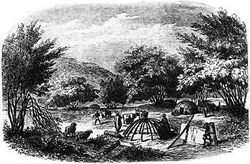Some of the oldest forms of human communication include talking or making sounds, drawing or painting, dancing, acting, and using symbols.
From sounds and symbols to written communication and language
Making sounds such as grunting or guttural sounds at a low pitch or high pitch would indicate either social communication or be a warning sign. Body language was also used as communication at this time. Later written communication came about when humans realised the need to record their daily life activities. Further down the line this progressed to meeting the needs of bartering and exchanging of goods. The ancient Egyptians were amongst the first people to use symbols as a form of written communication which later developed into the alphabet system that we know today.
Language, symbols, songs, art and dance
Cave drawings were murals that people painted onto the walls of caves and canyons to tell the story of their culture. They would tell stories of battles, hunts and culture.
Storytelling was used to tell stories, both fiction and nonfiction, before there were books. It was a way for families and communities to pass on information about their past.
This infographic highlights all forms of communication through ages, click here to view
Drums were one way to send signals to neighbouring tribes and groups. The sound of the drumming patterns would tell them of concerns and events they needed to know.
Smoke signals were another way to send messages to people who were not close enough to use words with. Can you imagine living without your telephone? We sure have come a long way!
SAHO is still developing content for this section. If you have any content to send us or suggestions please click on 'contribute'.
Rock art For some great rock art images. Visit: www.kimberleycoastalcamp.com.au To download PowerPoint presentations on early man with great pictures and drawings. Visit: earlyhumans.mrdonn.org. The site also includes interesting ideas for games in the classroom.

San hunter-gatherers and the Khoi-Khoi herder
For many years it was widely believed that the only reliable form of knowledge was the written word. Books, diaries, documents, and newspapers.These commanded respect because their words could be preserved. But the printed word can be misleading. For example, certain history books taught, inaccurately, that Africans arrived in Southern Africa at more or less the same time as European settlers landed in the Cape. Some books emphasised differences amongst people. And while most textbooks acknowledged that the Khoisan had lived in South Africa for a very long time, the writers saw them as 'primitive', and paid very little respect to their history.
Their dance was after this fashion: on uttering the word 'hottentot!' they two of their fingers and clicked with tongue and feet, all in time ”Jan Olafsson, a visitor from Holland to the Cape".
When European settlers arrived in South Africa, most of them could read and write. They valued the written word as a precious form of knowledge. But European scholars made the mistake of thinking that writing was the only way that knowledge could be passed on. Where they did not find books in Africa, they simply assumed that Africa had no history.
”The Broken String” shows how wrong they were! Adapted from the school textbook by Emilia Potenza, this feature provides a taste of Africa's rich heritage, long before colonial times. South Africa's distant past may be learned not only through the written word, but through many other forms of evidence from human remains, pottery, tools, rock paintings and buildings, as well as from cultural traditions and the stories and memories passed on by the elders.
”The Broken String” presents this wealth of knowledge in a richly visual, well-informed and challenging way. Giving voice to the stories and experiences of the people themselves encourages more sensitivity to those people of the past, and to understanding their lives, needs and problems. “The Broken String” also approaches the learning of history in a fresh way, encouraging independent and creative exploration of ideas, people and events.
The content for San hunter-gatherers and the Khoi-Khoi herders, was adapted from a book titled 'The Broken String' was developed for the SAHO classroom by Emilia Potenza